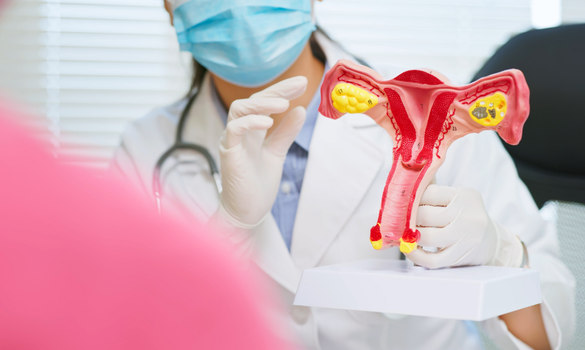What is Chocolate Cyst?
Chocolate cysts usually form when the tissue inside the uterus (endometrium) grows outside the uterus and are mostly seen in the ovaries. These tissues bleed during each menstrual period, but since they are outside the uterus, the body cannot easily clean this blood. This causes the formation of sacs that become cysts over time. It gets its name from the dark brown, chocolate-like fluid inside it.
Key Points:
- Chocolate cysts are commonly accompanied by endometriosis.
- These cysts may not show symptoms for a long time but can negatively affect quality of life in advanced stages.
Chocolate Cyst Symptoms
Chocolate cyst symptoms, while varying from person to person, commonly include:
- Painful menstrual periods (dysmenorrhea): Severe pain in the lower abdominal area during menstruation.
- Pain during sexual intercourse (dyspareunia): Discomfort or pain during deep intercourse.
- Infertility problems: Inability to get pregnant or difficulty in pregnancy.
- Chronic pain in the pelvic region.
- Menstrual irregularities.
If any of these symptoms are affecting your life, you should definitely consult a specialist.
How is Endometriosis Diagnosed?
Endometriosis diagnosis is usually made through a series of different methods since symptoms alone are not sufficient. These methods are:
1. Evaluation of Your Medical History
Your doctor takes the first step toward diagnosis by learning about your symptoms and medical history.
2. Physical Examination
During gynecological examination, physical signs pointing to the presence of endometriosis are investigated.
3. Ultrasound
Ultrasound is the first imaging method used to detect chocolate cysts and other abnormalities.
4. Laparoscopy
It is the gold standard method in endometriosis diagnosis. During this surgical procedure, a small camera is placed in the abdominal cavity and problematic tissues are observed directly.
Getting an expert evaluation and diagnosis with the right methods is a critical step for effective treatment in the future.
Effective Treatment of Endometriosis and Chocolate Cysts
Although endometriosis and chocolate cysts usually cannot be completely cured, it is possible to manage symptoms and improve quality of life. Expert gynecologists can create a personalized treatment plan to evaluate your condition.
Common Treatment Methods
Drug Treatment:
- Pain relievers to control pain.
- Hormonal treatments can slow the growth of endometriosis tissues.
Surgical Intervention:
- Laparoscopic surgery is often preferred to remove cysts and relieve symptoms.
- Minimal invasive techniques provide short recovery time.
Lifestyle Changes:
- A balanced diet, regular exercise and stress management can contribute to reducing symptoms.
Fertility Treatments:
- If infertility is a problem, assisted reproductive techniques such as in vitro fertilization can be evaluated.
Impact of Chocolate Cysts on Daily Life
The effects of chocolate cysts can shape not only women's physical but also emotional and social lives. Pain, low energy and fertility concerns can make it difficult for individuals to fulfill their daily responsibilities. Early diagnosis and proper treatment play a critical role in reducing these effects.

